VisionThe outer portion of the eyeball consists of a tough, whitish layer of connective tissue called the sclera. This, in turn, surrounds a thin, darkly pigmented layer, the choroid. A transparent cornea, actually a part of the sclera, at the front of the eye allows light to enter. The choroid at the front of the eye forms the iris which is capable of changing the diameter of its pupil. After going through the pupil, light passes through a disk-like lens which is held in position by ligaments and muscles attached to the choroid. The lens focuses light onto the retina, a layer just inside the choroid at the rear of the eye. Photoreceptor cells within the retina transduce light energy to chemical energy, forming action potentials which pass via sensory neurons in the optical nerve to the visual centers of the brain. Two fluid filled chambers make up the major volume of the eye: the chamber in front of the lens is filled with a liquid similar to blood plasma and is referred to as the aqueous humor; the chamber behind the lens is filled with a jelly-like material called the vitreous humor. These materials help to maintain the shape of the eye which is very important. Light is focused onto the retina by bending or refracting light rays. The human eye focuses by changing the shape of the lens (making it thin or thick). The changing of thickness is called accommodation. Lens elasticity lessens with age which leads to less accommodation ability and the need for corrective eye glasses ("bifocals" or reading glasses), a condition known as presbyopia. Most of you have had your vision tested and many of you have 20/20 vision. What does this mean? It means that you can read a line of letters or other symbols of a particular size accurately from a distance of 20 feet. Some of you may have a visual acuity of 20/10, which is much better than normal. This means that you can read letters at a distance of 20 feet that most others can read only if they are within 10 feet of the chart. Others of you may have a visual acuity of 20/50, which is somewhat less than normal. This means that you must approach to a distance of 20 feet to read letters that most others can see from a distance of 50 feet. There are common visual defects. They include astigmatism, nearsightedness and farsightedness and they can all be corrected for with artificial lenses. Nearsighted people cannot focus well on distant objects because they have an eyeball that is longer than normal. (Recall that I mentioned that the shape of the eye is important.) Nearsighted people cannot flatten their lenses enough to compensate for the eyeball elongation and focus distant objects in front of their retinas rather than on them. 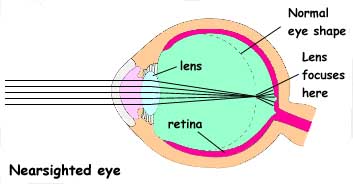 Nearsighted or myoptic people require glasses or contact lenses that are thinner in the middle than at the outer portions. These divergent lenses make the light entering the eye diverge a bit. This, in conjunction with the natural eye lens, allows an image to formed on the retina rather than in front of it. 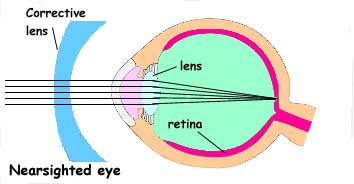 Farsighted individuals can focus on distant objects well enough but cannot focus on an object close to them. Such hyperoptic people have an eyeball that is shorter than normal. Their lenses focus an image behind the retina rather than on it. 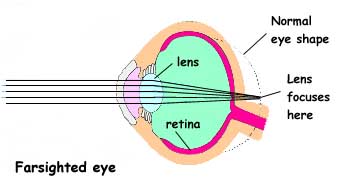 Farsighted individuals require glasses or contact lenses that are thicker in the middle than at the outer portions. This kind of lens causes light to converge a bit before entering the eye. The natural lens of the eye is then able to focus this onto the retina properly. 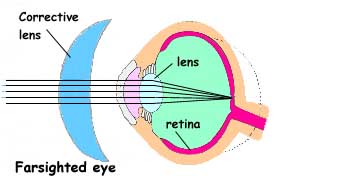 Do not confuse the farsightedness of presbyopia (farsightedness due to loss of elasticity of the lens) with that of hyperopia. Astigmatism is visual defect caused by a misshapen cornea or lens. These defects are asymmetric and require asymmetric lenses for correction. Astigmatism can cause severe blurring of vision. Let's look more closely at the nature of the retina. It is composed of about 130 million photoreceptor cells- the rods and cones of the eye.  
Rods are 20 times more numerous than cones and are much more sensitive to light. They allow us to see in dim light at night but do not give us any perception of color. Cones are fewer, are stimulated by bright light and allow us to distinguish color. They don't do much for us as far as night vision. In humans, rods are found mostly at the edges of the retina and are absent at the center. This is why, at night it is best to use your peripheral or edge vision to try to see faint things. Looking directly at a faintly lit object at night attempts to use a region of your retina ill-equipped for night vision. On the other hand, in the daytime, it is best to look directly at an object of interest. Then, your retinal cones, which are quite able to discern objects brightly lit are brought to bear on the item of interest. Just how do rods and cones detect light? You might revisit the electron micrograph of a section through retinal tissue. Rods and cones have stocks of membranous disks and an associated light- sensitive pigment. The light-sensitive pigment of rods is called rhodopsin, which is able to detect dim light. Cones, on the other hand, have visual pigments called photopsins, which are able to detect bright, colored light. There are three different types of cones with three different variants of photopsins, each particularly sensitive to either red, blue or green light but all able to detect a wide range of color. Color blindness arises from a deficiency in one or more types of cones. Below is one plate from a standard colorblindness screening kit. Those with red-green colorblindness cannot see the number "15" in this plate. 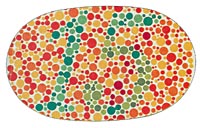 When rhodopsin and the photopsins absorb light, they change chemically. This change results in permeability changes in their associated membranes which in turn leads to action potentials being passed across numerous synapses between and among associated neurons. This integrated system helps to sharpen an image and increase its contrast. Ultimately, the image information is passed to the vision centers of the cerebral cortex. 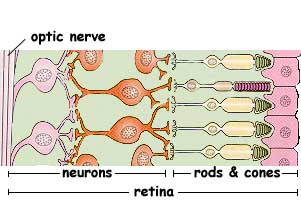 There are several conditions that affect vision. When any of them diminish central visual acuity to less than 20/200 and limit the field of vision to an angle of 20 degrees or less, the person is said to be blind. Surprisingly, the most common form of eye disease is mechanical injury due to a contusion, concussion, penetrating wound or perforating wound. Many such injuries are preventable. Wear protective lenses when doing things that could result in eye injury. Cataracts are opacities that form within the lens of the eye. The opacification is often due to the accumulation of interfibrillar fluid and the precipitation of proteins within the lens. Some diseases such as diabetes mellitus can cause cataracts. Senile cataracts also occur and are most likely due to senescent degenerative changes in the lens (old age!!). Retinitis pigmentosa is an inherited premature degeneration of the neuroepithelium which begins early in life and slowly progresses to blindness by age 50 to 60. The process begins at the periphery of the retina and moves progressively towards the center. The rod and cone layer of the retina essentially disappears. Glaucoma is a complex of diseases characterized by an elevated intraocular pressure. This is almost always due to tissue changes which decrease the outflow of aqueous humor from the eyes. Pressures above 23 mm of Hg can damage the eye by capillary compression. Here is how it works. Aqueous humor is formed by the epithelial cells of the ciliary body at the rate of about 0.002 ml per minute. This is normally moved from the chambers of the eye back into the venous system. Anything that blocks this movement leads to increased intraocular pressure and ultimately to vision loss because the capillaries supplying the retinal ganglion cells are squeezed shut and deprive the ganglion cells of oxygen and nutrients. A routine physical examination should always include a measuring of intraocular pressure. You may take a quiz on the material in this module. No record of the quiz is made. You decide after the quiz if you really know this material. You may also return to the Syllabus Page.
|